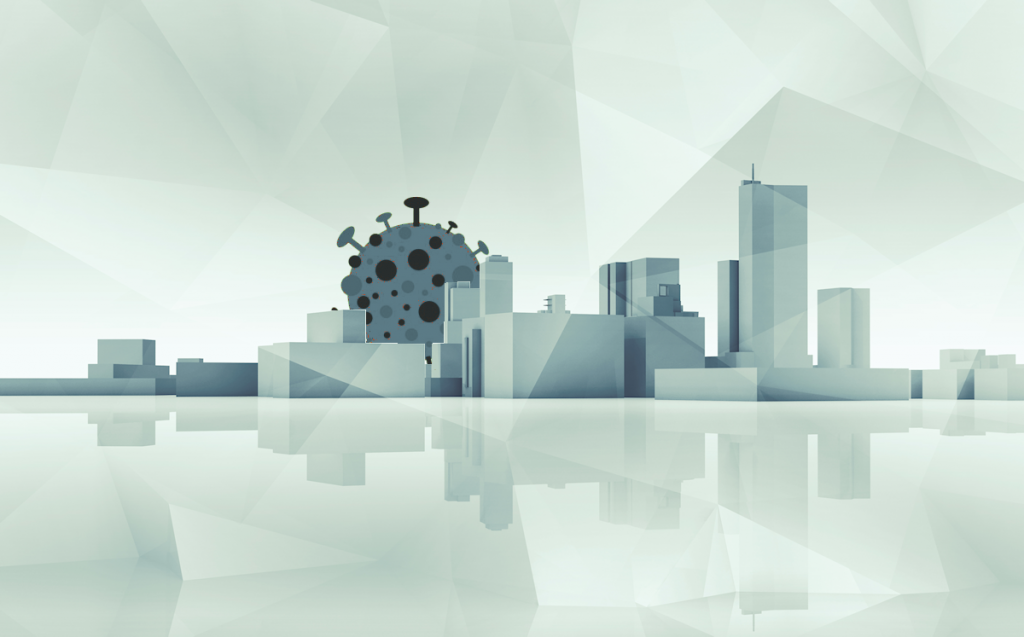Cities have historically been catalysts of growth, innovation, and efficiency. They remain important and their importance will only grow as the world continues to urbanize. The novel coronavirus pandemic, however, has also revealed the darker side of urban living. The very trait that makes cities important — congregations of people — also makes cities vulnerable to communicable diseases. The pandemic even has some people questioning whether urbanization should be discouraged. For example, Joel Kotkin (@joelkotkin), executive director of the Urban Reform Institute, writes, “The impact of the coronavirus pandemic may be too early to measure, but it’s clear that the great preponderance of cases, and deaths, are concentrated — at least as of now — in dense urban centers, most particularly Wuhan, Milan, Seattle, Madrid, and New York City. This crisis is the right moment for the world to reconsider the conventional wisdom that denser cities are better cities. Sadly, many of the attractions that make places like New York so unique and appealing also make them more dangerous. Crowds, mass transit, clubs, and huge cultural venues create a perfect terroir for the spread of pathogens.”[1] It’s also true that smart city technologies helped urban areas cope with the outbreak. Many pundits believe technology can help cities do even better when the next crisis hits.
Smart technologies and initial response
In order to save lives during a pandemic, the most important thing decision-makers can do — be they government officials, healthcare professionals, or business owners — is prevent the spread of the pathogen. In addition to social distancing, sanitizing, and widespread testing, contact tracing is proving to be an important tool. Scott Gottlieb (@ScottGottliebMD), a Resident Fellow at the American Enterprise Institute, and his AEI colleagues, Caitlin Rivers, Mark McClellan, Lauren Silvis, and Crystal Watson, write, “We need to harness the power of technology and drive additional resources to our state and local public-health departments, which are on the front lines of case identification and contact tracing.”[2] Veronica M. Combs (@vmcombs) reports Singapore and South Korea, two countries praised for their coronavirus response, relied heavily on contact tracing. She writes, “South Korea and Singapore are taking a smart city approach to halting the spread of the coronavirus. Both countries have been using contact tracing to identify people who have been exposed to the virus as well as all the people who had interacted with an infected individual.”[3] Germany, another country praised for it pandemic response, is relying on the honesty of infected individuals rather than technology to conduct contact tracing. The reason is privacy.
Privacy concerns are paramount when it comes to contact tracing. Journalist Simon Chandler admits contact tracing technologies provide valuable data; nevertheless, he expresses concerns about privacy. He writes, “The use of masses of connected sensors makes it clear that the coronavirus pandemic is — intentionally or not — being used as a testbed for new surveillance technologies that may threaten privacy and civil liberties. So aside from being a global health crisis, the coronavirus has effectively become an experiment in how to monitor and control people at scale.”[4] In an effort to help, Apple and Google announced the release of an app people could use to help them know whether they have come in contact with someone who has been exposed to the virus. However, the app doesn’t share that information with healthcare and government systems. Alex Hern (@alexhern) reports, “Apple and Google are encouraging health services worldwide to build contact-tracing apps that operate in a decentralized way, allowing individuals to know when they’ve been in contact with an infected person but preventing governments from using that data to build a picture of population movements in aggregate.”[5] Combs admits privacy issues are tricky. She explains, “The challenge is to balance the public good of protecting human health in the short term with diminished personal privacy and a stronger surveillance state by the government.” When the full story about the Covid-19 pandemic is told, we should learn a lot about achieving that balance.
Jim Frazer (@jamesjfrazer), a Senior Leader in Smart City Strategy Development and Implementation at ARC Advisory Group, observes social media is also playing an important role during the pandemic. He writes, “The importance of community cohesion and a coordinated response to the coronavirus pandemic has been demonstrated through citizen dialogues on NextDoor, a community building smart city platform. Of course, many other community platforms are also just as important — from Twitter to Facebook and even Meetup.”[6]
Stress testing smart cities
Journalist Loredana Pianta (@LoredanaPianta) believes the pandemic is a turning point for smart cities. She writes, “From the Covid-19 crisis we are learning a historic lesson about transforming our towns and cities. We’ll probably see a smart city concept B.C. and A.C, before coronavirus and after coronavirus.”[7] She adds, “This emergency has boosted the development of new technologies and collaboration between countries. It has shown the importance of data sharing and it has put infrastructure and legislative frameworks to the test, especially in the privacy domain. In many ways, what the threat of climate change has done over the last few years, the virus has done in just a few months.” Journalist Kim Hart (@khart) agrees the pandemic will have a long-lasting effect on cities. She writes, “The coronavirus pandemic will leave its mark on urban centers long after the outbreak itself recedes. The most densely populated cities are ground zero for the virus’ rapid spread and highest death tolls — and they’re also likely to be pioneers in making lasting changes to help prevent the same level of devastation in the future.”[8] Being prepared for the next pandemic is important. Hart explains, “The combination of urbanization, climate change and a hyper-connected society means infectious disease epidemics are likely to become more common, the World Economic Forum warns.” Hart provides predictions from several experts about how they think post-pandemic cities will change. They include:
- Buildings: In addition to becoming more connected, “building owners and builders should improve air ventilation and filtration to control microbes and mold in the air. Increasing indoor humidity can also help us to be less susceptible to germs. Meeting areas like entryways and public transit stations should be designed with enough space to avoid over-crowding — like separate staircases for ascending and descending traffic.”
- Streets and sidewalks: Because communicable diseases spread faster when people are crowded together, experts predict there may be an acceleration of street closures to vehicular traffic so people have more space to get around safely.
- Transportation: It may take a while for people to return using public transportation because rush hour usage places them too close to others. Other forms of transportation, like private vehicles, e-scooters, bicycles, and walking may become more popular. Public transportation officials are going to have to figure out a way to make people safe again.
- Airports: Temperature checks and other health screenings will likely become more common. Middle seats may be left vacant on flights until a majority of the public has been vaccinated. Physical barriers may be used to enforce social distancing.
- Remote work: Remote work may gain broader acceptance. If this happens, commuting may be decreased and cities may be less crowded.
- Digital services: Cities are learning to provide more services digitally and this trend may continue to increase.
- How we shop, eat and gather: To encourage people back into restaurants and other public venues, social distancing rules may remain in place for some time. On the brighter side, public venues may stress cleanliness and use it as a selling point to attract customers.
Hart concludes, “In many cases, the COVID-19 outbreak will accelerate trends that were already underway. The new normal may, in fact, feel pretty normal.” Phillip Kash, Partner at HR&A Advisors, told Hart, “At the end of the day cities shall remain, they just may transform into something a little bit different.”
Footnotes
[1] Joel Kotkin, “After coronavirus, we need to rethink densely populated cities,” Fortune, 1 April 2020.
[2] Scott Gottlieb, Caitlin Rivers, Mark McClellan, Lauren Silvis, and Crystal Watson, “National coronavirus response: A road map to reopening,” American Enterprise Institute, 29 March 2020.
[3] Veronica M. Combs, “How smart city tech is being used to control the coronavirus outbreak,” TechRepublic, 30 March 2020.
[4] Simon Chandler, “How Smart Cities Are Protecting Against Coronavirus But Threatening Privacy,” Forbes, 13 April 2020.
[5] Alex Hern, “NHS in standoff with Apple and Google over coronavirus tracing,” The Guardian, 16 April 2020.
[6] Jim Frazer, “Coronavirus and The Importance of Smart City Platforms,” ARC Advisory Group Blog, 16 March 2020.
[7] Loredana Pianta, “Covid-19 crisis: a stress-test for smart cities,” Youris.com, 16 April 2020.
[8] Kim Hart, “How the pandemic will reshape cities,” Axios, 1 April 2020.





